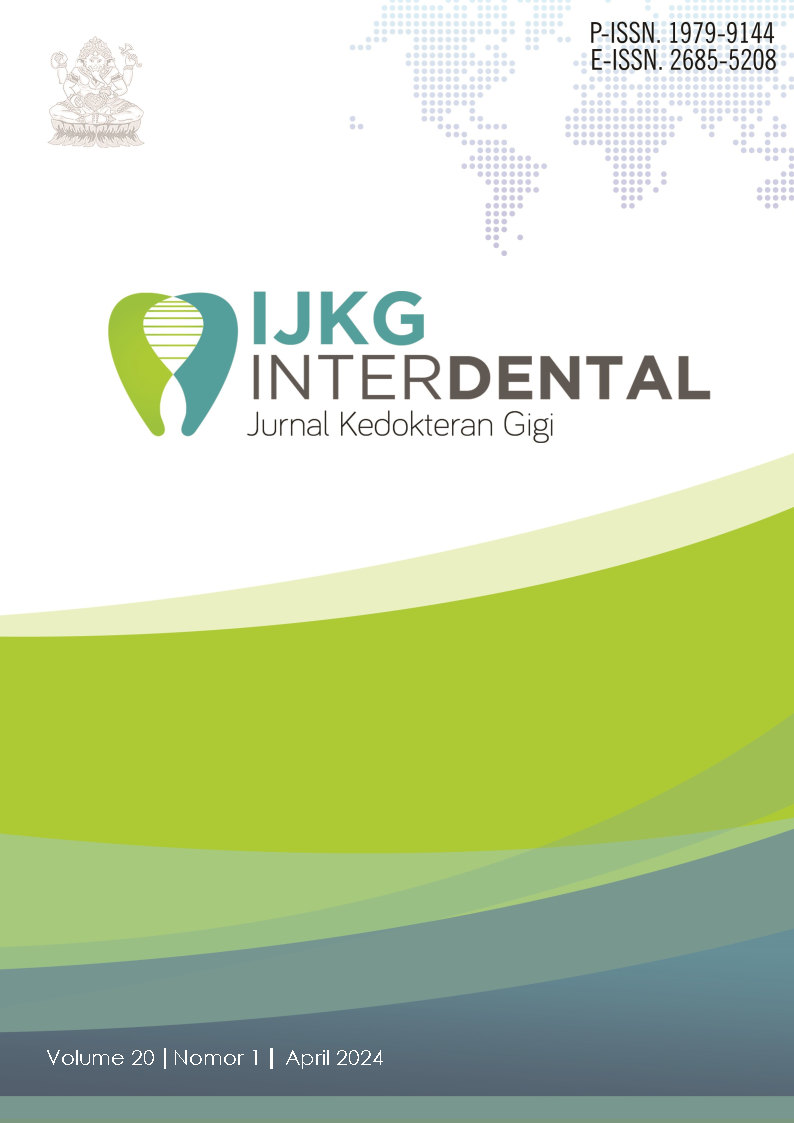INCIDENCE OF ORAL CANDIDIASIS IN FIXED ORTHODONTIC APPLIANCES
DOI:
https://doi.org/10.46862/interdental.v20i1.8505Keywords:
Incidence, oral candidiasis, orthodontic fixAbstract
Introductions: Oral candidiasis is most often caused by Candida albicans, followed by C. glabrata. In European countries, an analysis showed that more than half of candidiasis cases were caused by C. albicans and the infection rate caused by other candida strains was 14% for C. glabrata and C. parapsilosis, 7% for C. tropicalis and 2% for C. krusei. According to a study in Brazil, C. albicans accounted for 40.9% of cases followed by C. tropicalis (20.9%), C. parapsilosis (20.5%) and C. glabrata (4.9%). Meanwhile, in Indonesia, there is no national data regarding the epidemiology of oral candidiasis in Indonesia. Hospital Dr. Hasan Sadikin (RSHS) Bandung conducted research from 2010-2014 and found that during that period 49 patients had oral candidiasis. In general, side effects can be felt by patients who are in fixed orthodontic treatment which affects comfort and quality of life, namely 42.79% experience a sensation of pain in the area of the oral cavity, while 51.80% complain of discomfort when chewing food and this can indicate that Orthodontic appliances are mainly the patient's daily activities, the second is related to chewing food, phonetics and smile lines. The purpose of this study was to determine the incidence of candidiasis on orthodontic appliances. This study was to determine the incidence of candidiasis on fix orthodontic appliances.
Material and Methods: In this study, 80 samples were obtained from the total population, namely medical students who use fixed orthodontics with metal materials. Methods with SWAB examination on the surface of the bracket and the oral mucosa that intersect with the ortho-adhesive device. The results were recorded and then data analysis was carried out. Then the specimens were put in a microbiology incubator for 48 hours at room temperature. If candida albicans grows on the petridish then it is assessed that candidiasis is present.
Results: From the study, it was found that 80% incidence of candidiasis, 20% is normal.
Conclussions: There is a high incidence of oral candidiasis in patients using fix orthodontics appliances.
Downloads
References
Gravina, HG, de Morán, EG, Zambrano, O, Chourio, ML, de Valero, SR, Robertis, S, Mesa L. Oral Candidiasis in children and adolescents with cancer. Identification of Candida.spp. Med Oral Patol Oral Cir Bucal. 2007; 12:419-23
Lewis MAO, Lamey P-J. Tinjauan Klinis Penyakit Mulut/Clinical Oral Medicine. Alih bahasa. Wiriawan E. Jakarta: Widya Medica; 2008.
Alawiya T. Komplikasi dan resiko yang berhubungan dengan perawatan ortodonti. J Ilmiah Widya 2018; 4(3): 256-61.
Ardhana W. Identifikasi perawatan ortodontik spesialistik dan umum. Maj Ked Gi 2013; 20(1):1-8.
Egusa H, Soysa N.S, Ellepola.AN, Yatani H, Samaranayake LP. Oral candidiasis in HIV infected patients. Curr HIV research 2008;6:485- 99.
Akpan A, Morgan R. Oral candidiasis. Postgrad Med J 2002; 78: 455–59
Lehmann PF. Fungal structure and morphology. Medical Mycology . 20098;4:57–8.
Peterson DE. Oral candidiasis. Clin Geriatr Med. 2009; 8:513–27.
Garber GE. Treatment of oral candida mucositis infections. Drugs. 2006;47:734– 40.
Epstein JB. Antifungal therapy in oropharyngeal mycotic infections. Oral Surg Oral Med Oral Pathol 2010;69:32–41
Epstein JB, Truelove EL, Izutzu KL. Oral candidiasis: pathogenesis and host defense. Rev Infect Dis 2012;6:96–106.
Parveen Surain Dabas. An approach to etiology, diagnosis and management of different types of candidiasis, Department of Microbiology, Kurukshetra University, Kurukshetra-136119, India: Haryana; 2013
Vila T, Sultan AS, Jauregui DM, Rizk MAJ. Oral Candidiasis: A Disease of Opportunity. Journal of Fungi 2020; 6(15): 1-28.
Singh A, Verma R, Murari A, Agrawal A. Oral candidiasis: An overview. Journal of Oral and Maxillofacial Pathology2014; 18(1): 81-85.
Hakim L, Ramadhian R. Kandidiasis Oral. Majority 2019; 4(9): 55-56
Downloads
Published
How to Cite
Issue
Section
License
Copyright (c) 2024 Wahyuni Dyah Parmasari, Masfufatun, Tri Juliati

This work is licensed under a Creative Commons Attribution-ShareAlike 4.0 International License.
- Every manuscript submitted to must observe the policy and terms set by the Interdental Jurnal Kedokteran Gigi (IJKG)
- Publication rights to manuscript content published by the Interdental Jurnal Kedokteran Gigi (IJKG) is owned by the journal with the consent and approval of the author(s) concerned.
- Full texts of electronically published manuscripts can be accessed free of charge and used according to the license shown below.













